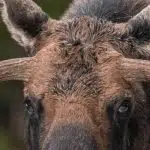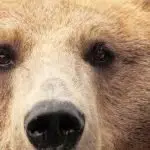If ever you are confronted with North America’s greatest cat, Puma concolor, thank your lucky stars. Very few of us are fortunate enough to see this consummate predator – a carnivore who can jump more than 10 feet up a cliff or 30 feet across a stream, who can sprint more than 40 mph to take down a Mule Deer or Elk. Almost certainly, many more of us have been seen by a Puma — also known as Cougar, Mountain Lion, Panther, Catamount, and various other names—than have been sharp-eyed enough to see the great cat in return.
Rare encounters
Although Pumas have the power to overcome potential prey several times their hundred-pound-plus size, they very seldom attack people. On extremely rare occasions when Pumas do attack people, the aggressor is usually a young displaced cat; and the intended prey is usually a small person appearing vulnerable, or a person who somehow looks more like a deer or other typical prey. We humans are not among Pumas’ search images for prey.
In the wildly improbable event that you are stalked by a Puma, you should face the animal and look as big and strong as you can. Throw rocks and sticks at the aggressor and he (less unlikely than she) will probably disappear silently into the trees or rocks. If the unthinkable happens and you are actually pounced upon, fight like hell while protecting your head and neck.
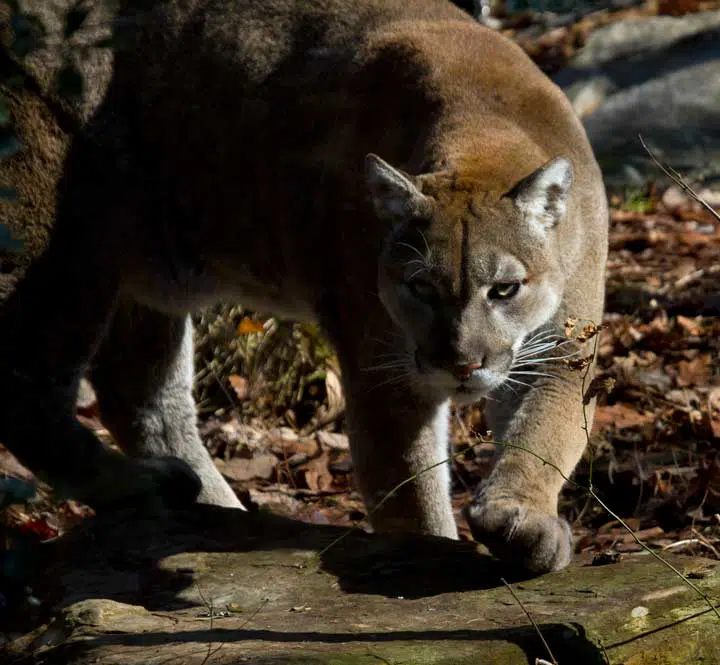
Perhaps once or twice a year in all of the United States, a person actually is attacked by a Puma; and even less often, about twice a decade on average, some unlucky person in the US is killed by a Puma. To put this in perspective, domestic dogs kill about twenty people a year in our country on average, collisions between cars and deer kill about two hundred a year, and more than thirty thousand people a year are killed in car accidents.
Safer with carnivores
Far from endangering people, top carnivores like Pumas and Wolves actually can make our lives safer. They help regulate the behavior and numbers of herbivores like deer, who in predators’ absence become unnaturally abundant. Predator/prey imbalances harm forest and other ecosystem health and heighten risks from zoonotic diseases like Lyme.
If ever there was a time in American history when we had reason to fear being eaten by bigger animals, it is past. The greatest dangers in our lives these days are self-imposed: fast cars, fast food, pollution … Cars kill thousands of times as many people as do animals. The large wild animal that kills the most people in the US now is deer—our elimination of native predators having allowed prey numbers to soar past natural levels, resulting in countless, sometimes fatal, collisions between cars and wildlife.
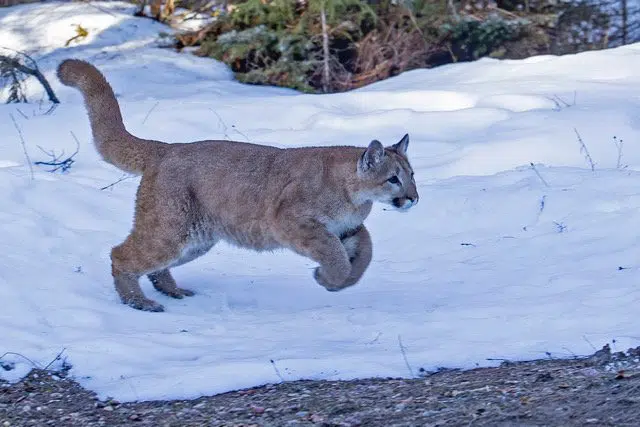
As a wildways scout, I’ve been fortunate to trek thousands of miles in recent years in many of the wildest parts of our country. I’ve seen most of North America’s native carnivores – always in positive, life-affirming experiences; but so far, I’ve seen Pumas only as tracks, scrapes, and carrion. Pumas are so elusive, you can live decades near them and never even glimpse one.
Pumas and either Red or Gray Wolves or both belong in most what is now the United States, as well as much of Canada and Mexico, and would be regulating deer herds, if present in ample numbers. The importance of native predators is not just in the deer they actually cull from the herd – usually, the weaker ones, whereas human hunters often go against natural selection by targeting the trophy animals; it’s also in how they keep the ungulates wary and moving, preventing over-browsing of wildflowers, white-cedars, and other preferred vegetation. John Laundre, author of Phantoms of the Prairie: The Return of the Cougar to the Midwest, and other biologists have used the term “ecology of fear” to stress the importance of top predators for behavioral changes. Absent their hunters, grazers, and browsers get chubby and complacent as they munch down the forest. The Rewilding Institute and Cougar Rewilding Foundation are among the groups calling for their return. We are fortunate to still have in the Appalachians and Adirondacks enough wild country and enough prey (deer especially, but also Beaver, Snowshoe Hare, and other smaller animals) to support Puma recovery. Pumas still survive in much of the West, but thousands are shot every year. (Sadly, Wolves have been eradicated from most of the East and most of the West south of Canada, though they’ve been successfully reintroduced in several areas, most famously Yellowstone National Park.)
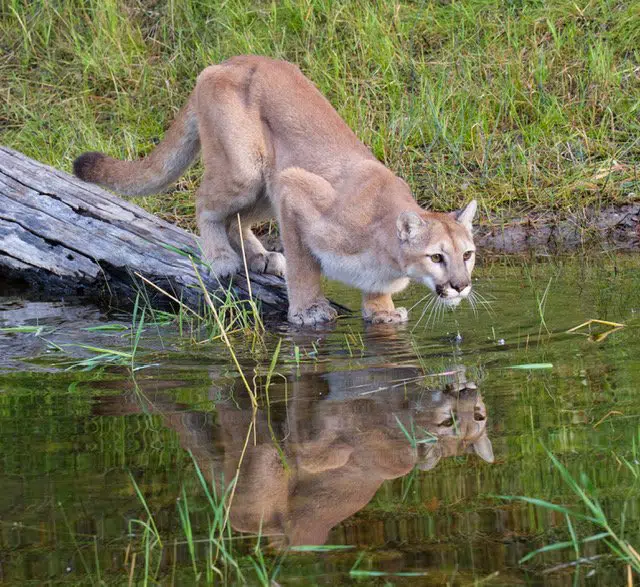
Welcoming them home
Many local residents where I live in New York’s great Adirondack Park insist the big cats – whether they call them Cougars, Pumas, Panthers, or Mountain Lions — are already here, or were never fully eradicated. To me, from readings and observations, it seems the many reported sightings of Pumas usually fall into several confusing categories: 1) people excitedly thinking they’re seeing Pumas when actually they are seeing the great cat’s smaller distant cousin, the Bobcat, or even a golden retriever or deer or another big tawny mammal; 2) released or escaped pet Pumas, for some people don’t care what the laws say about holding wild animals captive; 3) widely dispersing Pumas, usually young males, leaving areas out West where they are being shot and trapped and following forested connections eastward, but not finding mates, and eventually being shot or hit by cars in their search for new territories. The Cougar Rewilding Foundation has concluded that we do not now have, but would greatly benefit from, a functioning population of Pumas in our forests.
Our woods and our lives will be safer if we do allow return of Pumas and other missing predators. While the likelihood of being eaten by a big wild toothy animal is vanishingly remote, the likelihood of being sickened by Lyme disease or another emerging public health threat associated with fragmented ecosystems is significant. Pumas and Wolves and other predators hold in check numbers of the smaller animals that carry the parasites that carry such pathogens as the bacteria that cause Lyme disease. Intact, connected forests, extensive enough to house full suites of native predators, are healthier not just for wildlife but also for people in nearby towns. For evidence, take a long walk in the woods, starting in a badly logged woodlot then making your way to a big piece of protected forest, resting occasionally along the way to read from Richard Ostfelt’s book Lyme Disease: Ecology of a Complex System or Cristina Eisenberg’s The Wolf’s Tooth or Jim Estes and John Terborgh’s Trophic Cascades. Or follow Keeping Track founder Sue Morse on the paths of our homeland’s four-legged wanderers.
Far from fearing a dangerous encounter with a Puma, then, it is one of the wild sightings I want most. I’ll consider myself blessed if some day in some wild place I glimpse the great cat. I’ll consider that I’ve earned my keep on this beautiful Earth if I can help Pumas gain protections in the West and return to the East.
About the author
John Davis is a wild ways explorer, who has rambled across North American wildlands East and West. He is editor of Rewilding Earth and serves as a volunteer land steward for Eddy Foundation in Split Rock Wildway, eastern Adirondack Park, northern New York. His book BIG, WILD, AND CONNECTED: SCOUTING AN EASTERN WILD WAY FROM FLORIDA TO QUEBEC shares conservation lessons he learned along his 7600 miles TrekEast. The film BORN TO REWILD recounts his experiences exploring the proposed Spine of the Continent Wildway in the Rocky Mountains during TrekWest.
Featured image Credits: Larry Master


